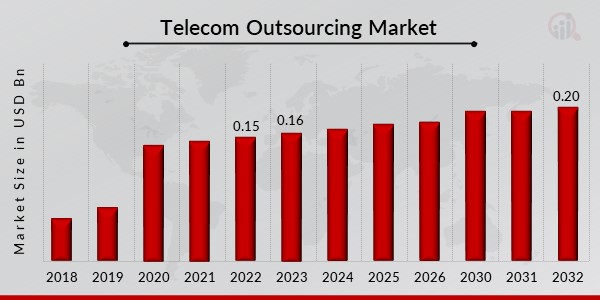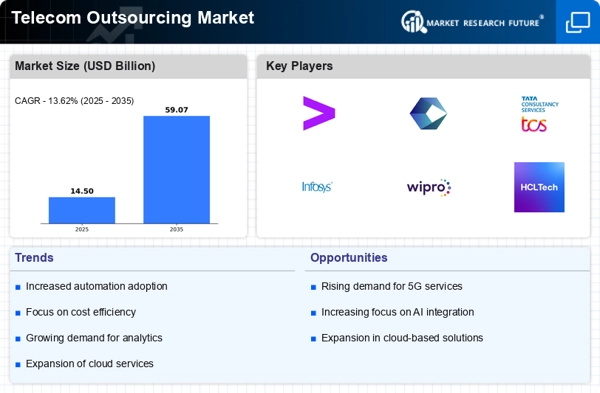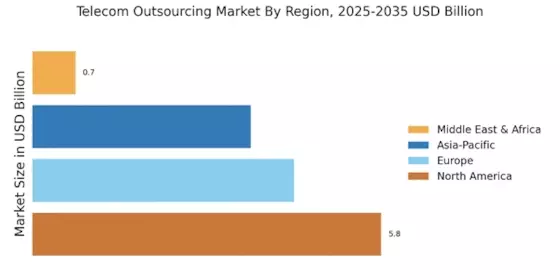Focus on Customer Experience Enhancement
Enhancing customer experience is a critical driver in the Telecom Outsourcing Market. As customer expectations evolve, telecom companies are increasingly outsourcing customer service functions to improve satisfaction and retention rates. By partnering with specialized service providers, firms can offer 24/7 support and personalized services that meet diverse customer needs. Data suggests that companies that invest in outsourced customer experience solutions see a 15% increase in customer loyalty. This focus on customer-centric strategies is reshaping the competitive landscape, as firms strive to differentiate themselves through superior service. Consequently, the Telecom Outsourcing Market is likely to expand as companies recognize the value of outsourcing in delivering exceptional customer experiences.
Technological Integration and Innovation
Technological integration plays a pivotal role in shaping the Telecom Outsourcing Market. The rapid evolution of technology necessitates that telecom companies adopt advanced solutions to remain competitive. Outsourcing partners often possess specialized knowledge and cutting-edge tools that can enhance operational efficiency. For instance, the adoption of artificial intelligence and machine learning in customer service has shown to improve response times and customer satisfaction. Data indicates that companies utilizing outsourced technology services experience a 20% increase in operational efficiency. This trend suggests that telecom operators are increasingly relying on outsourcing to access innovative technologies without the burden of in-house development. Consequently, the Telecom Outsourcing Market is poised for growth as firms seek to harness technological advancements through strategic partnerships.
Cost Efficiency and Resource Optimization
The Telecom Outsourcing Market is increasingly driven by the need for cost efficiency and resource optimization. Companies are seeking to reduce operational costs while maintaining service quality. Outsourcing non-core functions allows telecom operators to focus on their primary business objectives. According to recent data, outsourcing can reduce operational costs by up to 30%, enabling firms to allocate resources more effectively. This trend is particularly evident in regions where competition is fierce, compelling companies to streamline operations. By leveraging third-party expertise, telecom firms can enhance their service offerings without incurring substantial capital expenditures. This strategic shift not only improves financial performance but also fosters innovation, as resources are redirected towards research and development. As a result, the Telecom Outsourcing Market is likely to witness sustained growth driven by these economic imperatives.
Regulatory Compliance and Risk Management
The Telecom Outsourcing Market is significantly influenced by the need for regulatory compliance and risk management. As telecom regulations become more stringent, companies are compelled to ensure adherence to various legal standards. Outsourcing certain functions can mitigate risks associated with compliance, as specialized firms are often better equipped to navigate complex regulatory landscapes. For example, outsourcing data management to firms with expertise in data protection can help telecom operators avoid costly penalties. Recent statistics indicate that companies that prioritize compliance through outsourcing can reduce their risk exposure by approximately 25%. This trend underscores the importance of strategic outsourcing in managing regulatory challenges, thereby driving growth in the Telecom Outsourcing Market.
Scalability and Flexibility in Operations
Scalability and flexibility are essential components driving the Telecom Outsourcing Market. As market demands fluctuate, telecom companies require the ability to scale operations rapidly without incurring significant costs. Outsourcing provides a viable solution, allowing firms to adjust their service capacity in response to changing market conditions. For instance, during peak demand periods, outsourcing partners can quickly ramp up resources to meet customer needs. Recent analyses indicate that companies leveraging outsourcing for scalability can achieve a 30% faster response to market changes. This adaptability is crucial in a dynamic industry where customer preferences shift rapidly. Therefore, the Telecom Outsourcing Market is expected to grow as firms increasingly recognize the advantages of flexible operational models.


















Leave a Comment